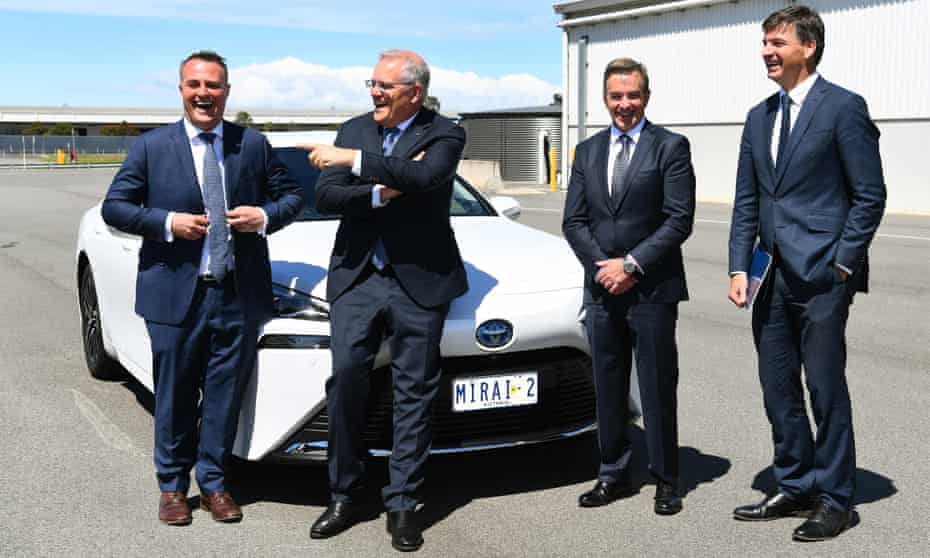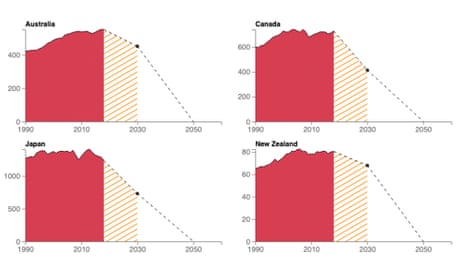Extract from The Guardian
Heading into the election, all focus should be on the carbon budget and how much we emit before net zero. Everything else is just noise

The election next year will be redolent with spin and obfuscation. Unfortunately, this will be most evident in relation to climate change policy. So let us prepare by outlining the reality of where we are at, and what the future holds.
First the good news: 2021 is on target to be the coolest year since 2014. The latest Nasa figures to October has 2021 on track to be around 1.1C above the late 19th century average.
The bad news is this “cool” year is still warmer than any year on record before 2015, and it marks the seventh consecutive year of the planet being more than 1C warmer than the late 19th century average.
The worse news is the year is so “cool” because the first half was in La Niña and had abnormally cool temperatures; but the second half of the year has been almost as warm as 2019 and 2020:
If the graph does not display please click here
So no, climate change has not stopped, and political parties still need a climate change policy.
This brings us to the spin and obfuscation.
The government, which is facing challenges from independents over a lack of action on emissions, is trying very hard to make it sound like it has actually done something.
Firstly, leadership? Excuse me while I stop my eyes rolling so hard they dislodge from their sockets.
At the recent Glasgow conference, the Morrison government was mainly leading in inaction and was named the “climate fossil” of the conference by the Climate Action Network.
But secondly, the only reason Australia’s emissions are down from 2005 levels at all is due to two things – the end of massive land-clearing in Queensland, and the pandemic:
If the graph does not display please click here
The cut in emissions from land use is purely because in 2005 there was massive land-clearing in Queensland, and now there is not.
Including land use makes Australia’s emissions reductions look good, which is why Australia has always fought to be able to count it:
The pandemic also caused a massive drop in emissions – mostly through reduced transport. Prior to the pandemic, Australia’s emissions excluding land use were still above 2005 levels, and even now, they are a mere 2.9% below 2005:
If the graph does not display please click here
But this talk about the past is designed to make us not worry about the future, and what needs to be done.
The government currently projects emissions (including land use) by 2030 to be 30% below 2005 levels. While the government’s 24%-26% target has not changed, I am content to use this projection as its current path.

The problem, as I have noted in the past, is that the big issue with climate change policy is not 2030 targets or net zero, but how much we emit before getting to net zero.
We can only emit a certain amount before temperature rises above 1.5C or 2C are inevitable.
The Climate Targets Panel estimated earlier this year that Australia’s share of the global 1.5C carbon budget was 7,760m tonnes of CO2 from 2013-2050 and 10,400m tonnes of CO2 to stay under 2C.
That means from 2020 onwards we can only emit 6,113Mt CO2 to keep within or 2C budget and 3,473m tonnes to stay within the 1.5C budget.
The ALP’s plan to cut emissions by 43% below 2005 levels will also breach the 1.5C budget in 2028, and it breaches the 2C budget (assuming a path to net zero by 2050) by 2037:
If the graph does not display please click here
Given limiting temperatures to a 1.5C rise appears gone, the focus needs to be on the 2C budget. Under the government’s path, to stay within the 2C budget we would need to get to net zero by 2037 not 2050:
If the graph does not display please click here
In this coming election there will be a lot of spin about what has been done and what needs to be done to limit temperature rises.
Upon hearing the 20% cut claim, journalists should note that it is due to land-clearing changes which had nothing to do with the federal government, and drops in emissions during the pandemic, which are now being reversed.
And all focus should be on the carbon budget – journalists should be asking all parties what they are doing to keep cumulative emissions below the levels needed to limit warming to 2C, and what that means for cuts after 2030.
Everything else is just spin.
No comments:
Post a Comment